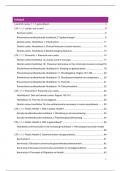Samenvatting
Samenvatting LTK 1.1.1 Gezondheid en Mondgezondheid + aangevuld na het tentamen. Tandheelkunde bachelor 1
Samenvatting voor het tentamen van het eerste cyclus LTK 1.1.1. 'gezondheid en mondgezondheid'. In deze samenvatting heb ik alle seminars samengevat + alle leerstof uit de boeken en artikelen (zie ook overzicht op eerste pagina's). Na het tentamen heb ik de samenvatting aangevuld en uitroeptekens g...
[Meer zien]





